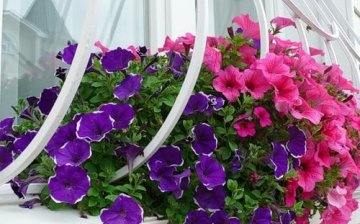Petunia surfiniya - features of growing and care
In Russia, it is customary to call all ampel petunias surfinia, although this name is erroneously used for all ampel petunias. But that's how it was with us. In reality, only one varietal group of petunias is called surfinia.
But since we have stuck with the name of petunia surfiniya, then let the terminology remain.
Are there any differences in the care and cultivation of surfinias and regular petunias?
The main difference is that surfinia's shoots are long, like whips, which allows you to decorate balconies, hedges, walls of gazebos, and so on with these flowers.
It is better to choose sandy loam or loamy soil for planting surfinia petunias. It is desirable that the soil consisted of the following components: peat, sand, leaf and sod land, humus.
Surfinia petunia will bloom more luxuriantly and longer if placed in well-lit areas. If you want to grow ampelous petunia in boxes or hanging pots, then when transplanting seedlings in containers, they are planted tightly.
Petunias are quite resistant to high temperatures and dry periods, although they will not be much harmed by abundant watering. But it is a bad idea to flood the plants, since the stagnant water of the petunias of the surfinia may not tolerate. Flowering will be facilitated by regular fertilizing. Feed the plants with mineral fertilizers at least once a week when watering.
Surfinia petunias have long lashes, but it is not specifically required to cut off and somehow form the plants. Ampelous petunias can only be propagated by cuttings, therefore always make sure that varietal petunias vegetate in case of need to cut cuttings.



